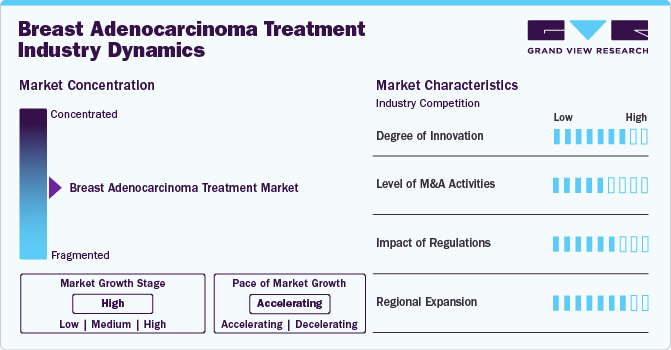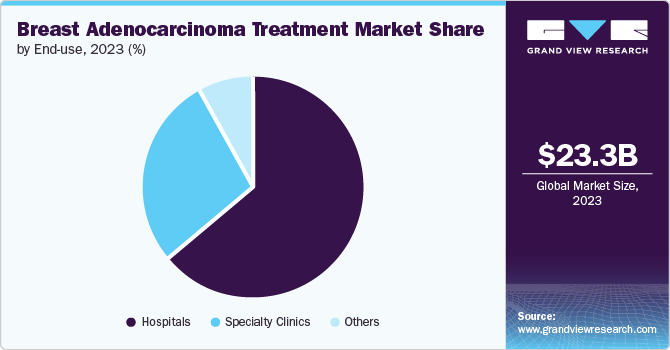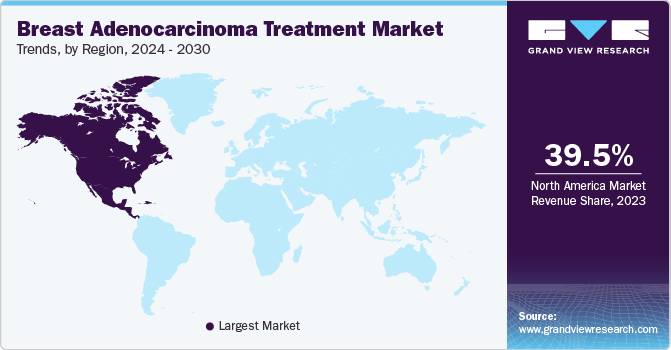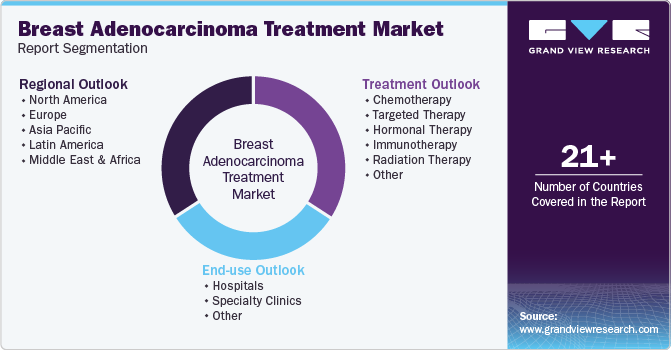
Breast Adenocarcinoma Treatment Market Size, Share & Trends Analysis Report By Treatment (Chemotherapy, Targeted Therapy), By End Use (Hospitals, Specialty Clinics), By Region, And Segment Forecasts, 2024 - 2030
- Report ID: GVR-4-68040-425-7
- Number of Report Pages: 120
- Format: PDF, Horizon Databook
- Historical Range: 2018 - 2022
- Forecast Period: 2024 - 2030
- Industry: Healthcare
Market Size & Trends
The global breast adenocarcinoma treatment market size was estimated at USD 23.3 billion in 2023 and is projected to grow at a CAGR of 9.1% from 2024 to 2030. The market growth is driven by the increasing prevalence of breast cancer, advancements in medical technology, rising awareness, and early detection. Breast adenocarcinoma, a common subtype of breast cancer, represents a significant health burden globally. According to the WHO, in 2022, there were 2.3 million women diagnosed with breast cancer and 670,000 deaths globally. This high incidence drives substantial demand for effective treatments, highlighting the critical need for ongoing research and innovation in this field.

The rising incidence of breast cancer, coupled with increased public awareness and advancements in both diagnostic and therapeutic technologies, plays a significant role in market growth. Enhanced screening programs and awareness campaigns have significantly improved early detection rates, leading to more cases being identified at earlier stages. For instance, a study from the National Library of Medicine reveals that supplemental screening for women at higher risk detects an additional 4.2 cancers per 1,000 women. This higher detection rate has expanded the pool of patients requiring treatment. Moreover, progress in molecular biology and genomics has transformed the understanding of breast adenocarcinoma, paving the way for more personalized and effective treatment strategies.
Recent advancements in breast adenocarcinoma treatments highlight a significant shift towards personalized and targeted therapies. Traditionally, treatment options include surgery, radiation, chemotherapy, and hormone therapy. However, the introduction of targeted therapies like CDK4/6 inhibitors (palbociclib, ribociclib, abemaciclib) has transformed care for hormone receptor-positive breast cancer by disrupting cell cycle progression and extending progression-free survival. In addition, PARP inhibitors such as olaparib and talazoparib show promise for tumors with BRCA1 or BRCA2 mutations, offering new options for genetically predisposed patients. Immunotherapy, including checkpoint inhibitors and antibody-drug conjugates, is also being explored to enhance the immune system's ability to target cancer cells. Integrating genomic profiling tools such as Oncotype DX and MammaPrint represents a shift toward precision medicine, allowing for more personalized treatment plans based on individual tumor characteristics, improving outcomes, and reducing unnecessary treatments.
The market for breast adenocarcinoma treatment is significantly impacted by ongoing research and clinical trials exploring new drug combinations and therapeutic targets. Researchers are delving into the molecular mechanisms of breast cancer to develop more effective and less toxic treatments. For example, recent studies highlighted by the American Cancer Society in February 2024 explore innovative imaging techniques such as scintimammography, positron emission mammography (PEM), electrical impedance imaging (EIT), elastography, and advanced optical tests, which may improve or replace current methods. Advances in treatment research include shorter radiation courses, proton beam therapy, and new drug combinations. Emerging therapies for aggressive cancers like triple-negative breast cancer focus on immunotherapy, cancer vaccines, and overcoming drug resistance. Additional efforts are aimed at refining strategies for hereditary breast cancer and assessing chemotherapy's role in HER2-positive cases, emphasizing comprehensive cancer care that also addresses side effects and overall well-being.
Market Concentration & Characteristics
The market for breast adenocarcinoma treatment is characterized by a high degree of innovation driven by continuous advancements in understanding the molecular mechanisms of breast cancer. The emergence of targeted therapies, such as HER2 inhibitors and novel hormone receptor modulators, has revolutionized treatment paradigms. Innovations like CDK4/6 inhibitors and PARP inhibitors represent cutting-edge approaches that enhance treatment efficacy and minimize side effects by focusing on specific cancer pathways and genetic mutations. The integration of precision medicine, including genomic profiling and personalized therapies, further exemplifies the market’s innovation landscape, enabling treatments tailored to individual patient profiles.
M&A activities in the market for breast adenocarcinoma treatment are notably vigorous as pharmaceutical and biotechnology companies seek to consolidate their portfolios and enhance their therapeutic offerings. Strategic acquisitions are often aimed at gaining access to innovative technologies, expanding product pipelines, or acquiring promising drug candidates still in clinical development. For instance, major pharmaceutical companies frequently acquire biotech firms specializing in breakthrough cancer therapies or cutting-edge diagnostics. This consolidation enables companies to accelerate the development and commercialization of new treatments, drive growth, and improve their competitive positioning in the market.

Regulatory frameworks play a crucial role in shaping the market for breast adenocarcinoma treatment. Regulatory agencies such as the U.S. Food and Drug Administration (FDA) and European Medicines Agency (EMA) establish rigorous standards for drug approval, ensuring that new treatments are both safe and effective. These regulations can significantly influence market dynamics by determining the speed at which new therapies are introduced and also their market accessibility.
Regional expansion in the pharmaceutical industry is increasingly focusing on emerging markets due to the rising prevalence of breast cancer and improving healthcare infrastructure in these areas. Key regions such as Asia Pacific, Latin America, and the Middle East are seeing a surge in investments as companies aim to benefit from enhanced healthcare access and growing patient populations. These areas present significant growth opportunities fueled by increased awareness, better diagnostic tools, and improved treatment access. Addressing disparities in breast cancer outcomes necessitates systematic improvements in the availability and quality of healthcare services. To support these efforts, the World Health Organization’s Global Breast Cancer Initiative (GBCI), launched in 2021, unites global stakeholders with the goal of reducing breast cancer mortality by 2.5% annually. This ambitious target aims to save 2.5 million lives over the next 20 years.
Treatment Insights
Based on treatment, this market is segmented into chemotherapy, targeted therapy, hormonal therapy, immunotherapy, radiation therapy, and others. Targeted therapy held the largest share of 27.6 % in 2023. This prominence underscores the transformative impact of targeted therapies on breast cancer treatment, reflecting a shift towards more precise and effective treatment modalities. Targeted therapy focuses on specific molecular targets associated with cancer cells, offering a tailored approach that contrasts with traditional broad-spectrum treatments like chemotherapy. The effectiveness of targeted therapies in breast adenocarcinoma can be attributed to their ability to interfere with pathways crucial for tumor growth and survival, thereby enhancing therapeutic outcomes and reducing collateral damage to healthy tissues.
Immunotherapy is anticipated to experience the fastest CAGR, with a projected CAGR of 12.6% during the forecast period. This growth is driven by increasing recognition of immunotherapy's potential, advancements in treatment strategies, and rising investment in research and development. Immunotherapy represents a transformative approach by harnessing the immune system to combat breast cancer, offering a significant departure from traditional treatments. As per the study published in December 2023 by the National Library of Medicine on the adoption and use of immunotherapy in breast cancer management, the efficacy of trastuzumab and pertuzumab for both early-stage and advanced HER2-positive breast cancer has been confirmed. In addition, immune checkpoint inhibitors like PD-1/PD-L1 inhibitors have been pivotal, especially for subtypes like triple-negative breast cancer (TNBC), where conventional therapies often fall short. The field is also experiencing growth through the development of cancer vaccines and CAR-T cell therapies. Cancer vaccines work by enhancing the immune system's ability to recognize and attack cancer cells, while CAR-T cell therapies involve engineering patients' T cells to more effectively target and destroy cancerous cells.
End Use Insights
Hospitals held the largest share of more than 60.0% in 2023. This growth is largely due to the high prevalence of breast cancer, which drives significant demand for hospital-based treatments. As one of the most frequently diagnosed cancers globally, breast adenocarcinoma necessitates extensive and complex care, making hospitals the primary setting for such treatments. Hospitals provide a comprehensive array of services, including advanced diagnostic tools, surgical interventions, chemotherapy, radiation, and targeted therapies. Their infrastructure and specialized personnel are crucial for managing complex and multimodal cancer treatments, such as combining surgery with chemotherapy and radiation or employing newer therapies like immunotherapy. Furthermore, hospitals play a vital role in clinical trials and research, often through affiliations with academic institutions, advancing breast cancer treatments and providing access to experimental therapies. This involvement enhances patient care and supports the shift towards personalized medicine, where treatments are tailored based on detailed genomic profiling.

The specialty clinics segment is set to grow significantly at a CAGR of 10.5%, driven by heightened demand for specialized cancer care, advances in treatment modalities, and the rise of personalized medicine. These clinics focus exclusively on oncology, offering concentrated expertise and resources for breast cancer diagnosis and treatment, including cutting-edge therapies and advanced clinical trials. Their specialization in novel treatments like targeted therapies and immunotherapies positions them at the forefront of innovation. Equipped with advanced diagnostics and personalized care, they enhance treatment efficacy and outcomes. In addition, the integration of multidisciplinary teams ensures comprehensive care, while patient-centered approaches and expanded insurance coverage make these clinics increasingly accessible and appealing to patients.
Regional Insights
The breast adenocarcinoma treatment market in North America held the largest global revenue share of 39.5% in 2023. The regional market is driven by the high prevalence of breast cancer and a well-established healthcare infrastructure. This dominance is fueled by substantial investments in research and development, leading to the availability of advanced therapies and early detection methods. The U.S. remains the largest market due to its advanced medical facilities, high incidence of breast cancer, and significant focus on innovative treatment approaches, such as targeted and immunotherapy.

U.S. Breast Adenocarcinoma Treatment Market Trends
The breast adenocarcinoma treatment market in the U.S. held a significant share in 2023 due to its advanced healthcare system and high breast cancer prevalence. Breast cancer is the most prevalent cancer among women, excluding skin cancers, and represents roughly 30% of all new female cancer diagnoses annually. For 2024, the American Cancer Society projects approximately 310,720 new cases of invasive breast cancer among women. In addition, about 56,500 new cases of ductal carcinoma in situ (DCIS) are expected. This condition is anticipated to cause around 42,250 deaths in women. The U.S. market benefits from substantial investments in research, development, and clinical trials, providing access to cutting-edge treatments. Regulatory bodies like the U.S. FDA play a crucial role in approving new therapies, contributing to the rapid introduction of innovative treatments.
The breast adenocarcinoma treatment market growth in Canada is also expected to rise due to increasing healthcare access and awareness campaigns. For instance, in December 2023, Breast Cancer Canada introduced Progress CONNECT, a new portal designed to help Canadian breast cancer patients access detailed information about their specific cancer types, treatment options, and care strategies. Recent data reveals a growing trend of Canadians seeking additional information online after receiving a cancer diagnosis. According to a survey conducted by Angus Reid Forum, nearly 73% of Canadians turn to search engines to better understand their diagnosis and explore treatment choices following their doctor's initial consultation. This shift underscores the increasing reliance on digital resources for health information and highlights the need for accessible, reliable platforms like Progress CONNECT to support informed decision-making and patient empowerment.
Europe Breast Adenocarcinoma Treatment Market Trends
The breast adenocarcinoma treatment market in Europe is poised for considerable growth during the forecast period. This growth is driven by an aging population, increased awareness about breast cancer, and advancements in treatment modalities. The European Union and national health authorities are actively involved in improving early detection and treatment standards. Countries such as the UK, France, Germany, and Spain are seeing advancements in precision medicine and targeted therapies.
The breast adenocarcinoma treatment market in the UK is expected to grow profitably due to a combination of government-funded healthcare initiatives, improved treatment protocols, and increasing cancer awareness. The National Health Service (NHS) provides comprehensive cancer care, including early detection and advanced treatments. For instance, in November 2023, Anastrozole, a drug previously used to treat breast cancer, received new licensing from the Medicines and Healthcare products Regulatory Agency (MHRA) as a preventive measure for women at high risk of disease. This new indication, granted through NHS England's Medicines Repurposing Programme, aims to prevent around 2,000 cases of breast cancer annually in England. Clinical trials have demonstrated that Anastrozole can reduce breast cancer incidence in post-menopausal women at increased risk by nearly 50%. Approximately 289,000 women with moderate-to-high risk, including those with significant family histories, could be eligible for this preventive treatment. If 25% of these women choose to use Anastrozole, it could not only prevent thousands of breast cancer cases but also save the NHS about more than USD 16 million in treatment costs. This country is also witnessing growth in personalized medicine and targeted therapies, which are supported by clinical research and patient advocacy groups. The focus on integrating new technologies and treatments into clinical practice is driving market growth.
The breast adenocarcinoma treatment market in France is experiencing growth due to emphasis on early detection and innovative treatments. France has a strong healthcare system with national health policies focused on improving cancer care and access to advanced therapies. The French government and health authorities, such as the National Institute of Cancer (INCa), are pivotal in driving improvements in cancer management and patient outcomes.
The breast adenocarcinoma treatment market in Germany benefits from its advanced healthcare infrastructure and a strong focus on research and development. This country's healthcare system supports comprehensive cancer care, including the latest treatments and technologies. Regulatory bodies like the Federal Institute for Drugs and Medical Devices (BfArM) play a crucial role in the approval and adoption of new treatments. Germany’s focus on improving early detection and personalized treatment options is driving market growth.
Asia Pacific Breast Adenocarcinoma Treatment Market Trends
The breast adenocarcinoma treatment market in Asia Pacific is projected to grow at a notable CAGR of 9.8%. This growth is driven by rising cancer incidences, improving healthcare access, and increasing awareness. According to the American Cancer Society, breast cancer is the most common cancer among women globally, representing 25% of all female cancers. In the Southeast Asia region, breast cancer mortality rates are projected to rise significantly, reaching 61.7% by 2040. This alarming trend underscores the urgent need for enhanced screening, early detection, and effective treatment strategies to address the growing impact of breast cancer in this region. Countries like India and China are witnessing significant market expansion due to growing healthcare infrastructure and awareness campaigns. Regional health organizations and governments are investing in cancer research, early detection programs, and treatment advancements, contributing to market growth.
The breast adenocarcinoma treatment market in Japan is growing due to its advanced healthcare system and emphasis on early detection. The Kao Group's Pink Ribbon Campaign, launched in October 2023 during Breast Cancer Awareness Month, aimed to raise awareness and promote early screening. Despite advancements in survival rates through early detection and treatment, Japan’s screening rates lag Western countries, contributing to a rising mortality rate. The Japan Breast Cancer Society is pivotal in addressing these issues by fostering research, education, and public health initiatives. It supports its mission through academic conferences, publications, and collaborations with national and international organizations. Japan’s healthcare infrastructure ensures comprehensive cancer care, offering access to cutting-edge treatments and technologies.
The breast adenocarcinoma treatment market in India is poised for significant growth, driven by increasing awareness, improving healthcare infrastructure, and rising incidence rates. According to the American Cancer Society, breast cancer is the most prevalent cancer among women in India, constituting 28.2% of all female cancers. In 2022, there were approximately 216,108 new cases reported. This high incidence highlights the critical need for improved awareness, early detection, and access to effective treatment options to address the growing breast cancer burden. The Indian government and health organizations are working to enhance cancer screening and treatment access. Initiatives by organizations such as the Indian Council of Medical Research (ICMR) are contributing to improved cancer care and patient outcomes.
The breast adenocarcinoma treatment market in Australia is experiencing growth due to heightened concerns about cancer and improvements in healthcare access. The Australian government and organizations like Cancer Australia are focusing on enhancing breast cancer awareness, early detection, and treatment options. The Australian healthcare system supports comprehensive cancer care driving market growth.
Latin America Breast Adenocarcinoma Treatment Market Trends
The breast adenocarcinoma treatment market in Latin America is witnessing robust growth driven by increased healthcare access, awareness, and advancements in treatment. The region is experiencing improvements in cancer care infrastructure and access to innovative therapies. National health authorities and organizations are working to enhance screening programs and treatment availability, contributing to market growth.
The breast adenocarcinoma treatment market in Brazil is expanding due to increased healthcare access and ongoing improvements in cancer care. Breast cancer, excluding non-melanoma skin cancers, is the most prevalent cancer among women in Brazil, followed by colorectal and cervical cancers. From 2023 to 2025, Brazil is anticipated to see approximately 73,610 new breast cancer cases annually, with an adjusted incidence rate of 41.89 cases per 100,000 women. This high incidence underscores the need for enhanced screening, early detection, and comprehensive treatment strategies to effectively address breast cancer in the country. The Brazilian Ministry of Health and other organizations are focusing on enhancing cancer screening and treatment infrastructure.
MEA Breast Adenocarcinoma Treatment Market Trends
The breast adenocarcinoma treatment market in the MEA region is experiencing significant growth driven by expanding healthcare facilities and increased focus on cancer treatment. Countries in the region are improving their cancer care infrastructure and investing in innovative treatments. The growing prevalence of breast cancer and efforts by regional health authorities to enhance treatment access are contributing to market expansion.
The breast adenocarcinoma treatment market in Kuwait is set to grow substantially, driven by a rising focus on advanced medical treatments and improved healthcare infrastructure. Kuwaiti government and health organizations are working to enhance cancer care and access to innovative therapies.
Key Breast Adenocarcinoma Treatment Company Insights
The market for breast adenocarcinoma treatment is characterized by the presence of several key companies that dominate the landscape with substantial market share. These companies are leading the industry through technological innovations, extensive distribution networks, and a broad portfolio.
Key Breast Adenocarcinoma Treatment Companies:
The following are the leading companies in the breast adenocarcinoma treatment market. These companies collectively hold the largest market share and dictate industry trends.
- Merck & Co
- Bristol Myers Squibb
- Kyowa Kirin
- Eisai Co.Ltd
- Sanofi
- Pfizer Inc
- AstraZeneca
- Novartis AG
- Eli Lilly and Company
- F. Hoffmann La Roche AG
Breast Adenocarcinoma Treatment Market Report Scope
|
Report Attribute |
Details |
|
Market size value in 2024 |
USD 25.44 billion |
|
Revenue forecast in 2030 |
USD 42.87 billion |
|
Growth Rate |
CAGR of 9.1% from 2024 to 2030 |
|
Base year for estimation |
2023 |
|
Historical data |
2018 - 2022 |
|
Forecast period |
2024 - 2030 |
|
Quantitative units |
Revenue in USD billion and CAGR from 2024 to 2030 |
|
Report coverage |
Revenue forecast, company ranking, competitive landscape, growth factors, and trends |
|
Segments covered |
Treatment, end use, region |
|
Regional scope |
North America, Europe, Asia Pacific, Latin America, MEA |
|
Country scope |
U.S.; Canada; Mexico; UK; Germany; France; Spain; Italy; Norway; Sweden; Denmark; Japan; China; India; Australia; Thailand; South Korea; Singapore; Brazil; Argentina; South Africa; Saudi Arabia; UAE; Kuwait |
|
Key companies profiled |
Merck & Co; Bristol Myers Squiib; Kyowa Kirin; Eisai Co.Ltd; Sanofi; Pfizer Inc; AstraZeneca; Novartis AG; Eli Lilly and Company; F. Hoffmann La Roche AG |
|
Customization scope |
Free report customization (equivalent up to 8 analysts working days) with purchase. Addition or alteration to country, regional and segment scope. |
|
Pricing and purchase options |
Avail customized purchase options to meet your exact research needs. Explore purchase options |
Global Breast Adenocarcinoma Treatment Market Report Segmentation
This report forecasts revenue growth at country level and provides an analysis of the latest industry trends in each of the sub-segments from 2018 to 2030. For this study, Grand View Research has segmented the global breast adenocarcinoma treatment market report based on treatment, end use, and region.

-
Treatment Outlook (Revenue, USD Billion, 2018 - 2030)
-
Chemotherapy
-
Targeted Therapy
-
Hormonal Therapy
-
Immunotherapy
-
Radiation Therapy
-
Other
-
-
End Use (Revenue, USD Billion, 2018 - 2030)
-
Hospitals
-
Specialty Clinics
-
Other
-
-
Regional Outlook (Revenue, USD Billion, 2018 - 2030)
-
North America
-
U.S.
-
Canada
-
Mexico
-
-
Europe
-
UK
-
Germany
-
France
-
Italy
-
Spain
-
Sweden
-
Denmark
-
Norway
-
-
Asia Pacific
-
Japan
-
China
-
India
-
South Korea
-
Singapore
-
Australia
-
Thailand
-
-
Latin America
-
Brazil
-
Argentina
-
-
Middle East & Africa
-
South Africa
-
Saudi Arabia
-
UAE
-
Kuwait
-
-
Frequently Asked Questions About This Report
b. The global breast adenocarcinoma treatment market, valued at USD 23.3 billion in 2023 and is anticipated to reach USD 25.44 billion in 2024.
b. The global breast adenocarcinoma treatment market is expected to grow at a compound annual rate of 9.1% from 2024 to 2030, reaching USD 42.87 billion by 2030.
b. Based on treatment, targeted therapy held the largest share of 27.6 % in 2023 owing to the high effectiveness of these therapies.
b. Some prominent companies in this market include Merck & Co, Bristol Myers Squibb, Kyowa Kirin, Eisai Co.Ltd
b. The market is driven by the increasing prevalence of breast cancer, advancements in medical technology, and rising awareness and early detection. Breast adenocarcinoma, a common subtype of breast cancer, represents a significant health burden globally.
We are committed towards customer satisfaction, and quality service.
"The quality of research they have done for us has been excellent."




